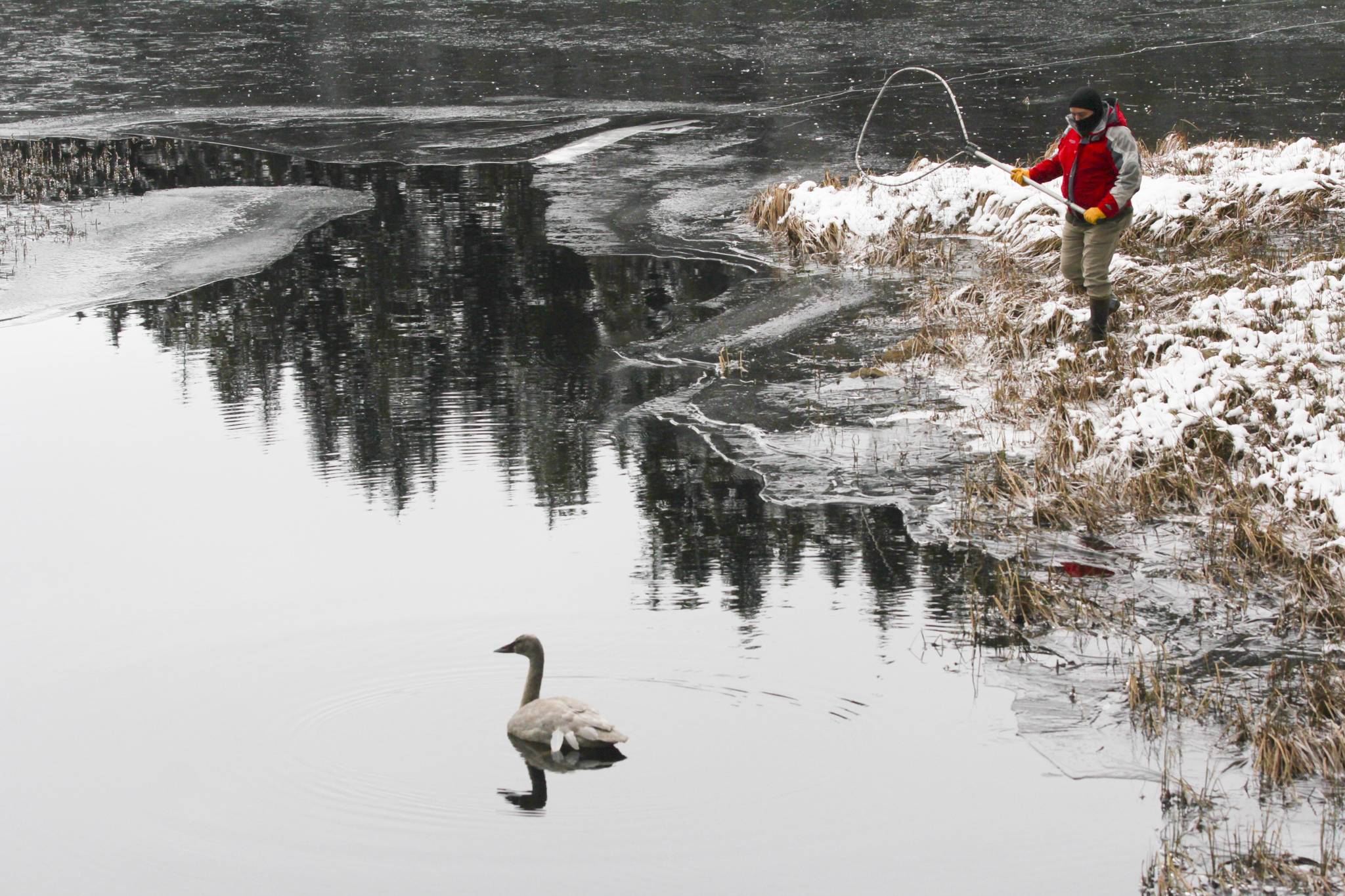It’s a icy, overcast day, and somewhere in Juneau, a swan is at large.
I’m driving on a Thursday afternoon to Auke Lake to meet with volunteers with the Juneau Raptor Center after a message from JRC manager Kathy Benner let me know that they’d be trying to apprehend a trumpeter swan with an injured wing.
“Rescues don’t usually go this way,” said Benner in an interview afterwards. “Rescues usually go, ‘There’s a bird in the road!’ and we go immediately. We’ve been trying to get this guy for weeks. This is the first time we’ve tried to rescue him.”
The swan has been on the raptor center’s radar for a while, Benner said, which isn’t super-common. The swan, a juvenile, is also sometimes referred to as a cygnet, a term I definitely didn’t learn just that afternoon.
“We’ve been keeping an eye on this swan since before Christmas,” Benner said. “He was here with a flock of trumpeters and they left, and he stayed here by himself.”
One sympathizes. On arriving at Auke Lake just before 2 p.m., I get out to take a look and immediately resolve to go nowhere near the ice, which appears to be slightly thicker and more supportive than plastic wrap. Benner texts to say they’re about to have a go of it, and I grab my gear and hustle over to the footbridge heading towards the college.
The scene unfolds before us. Two women, watching quietly and patiently from the bridge with cameras, like a golf match or an execution. In the trees on either side of the inlet, volunteers with poles. And at the center, gently steaming up the inlet, the intense focus of eight grown humans: the swan.
[Juneau Raptor Center rescues first bird of 2021]
“Honestly, I didn’t think we’d catch it. But I wanted to see what he’d do,” Benner said afterward. “We all had nets. If the bird comes your way and you have an opportunity, you take it.”
I rapidly unpack my back, fumbling on a long lens, and leaving a wide lens, a clipboard, and three children’s books I meant to mail to a relative piled on the bridge. The footbridge is the perfect observation point for what’s about to unfold, the layer of snow on the rails barely disturbed save for a few places where people leaned over to get a better look.
The plan is simple and recognizable to anyone who’s ever tried to herd a cat into a pet carrier: two people will approach from the right bank, with the intent of goosing the swan into the loving embrace of the people with nets on the left bank. At that time, Benner said, raptor center volunteer Pat Bock will bag the swan in a sheet, and they’ll bundle the bemused waterfowl back to JRC for an examination and fluids.
“Every single rescue, it’s not gonna be the same every time,” Benner said. “You just have to approach it and see what happens.”
The execution varies slightly from the hypothetical.
Benner’s husband, Tim Benner, approaches from position lakeward on the right bank. Michael Murphy stands ready with a net on the left bank for the swan to come closer. Kathy Benner backs up on the right bank, and Bock stands ready with the sheet.
For a moment, the bird entertains this, an interesting diversion from thinking about honking at things and doing swan stuff.
And then, like a frigate turning to open sea evading the crushing embrace of man-of-wars in the line of battle, the swan reverses course, and, with a flurry of speed, heads for the safety of the ice, deftly ending any attempt to apprehend the waterfowl this day.
“We couldn’t reach him with our nets. There’s ice, but there’s no walking on it. It’s not worth risking hurting him,” Benner says. “That’s one thing I learned from all of my years of doing this. You don’t risk your life.”
The group circles up for a quick afteraction as the swan saunters insouciantly onto the ice, far out of the range of these bipeds and their suspicious net-poles.
“He’s healthy, he’s strong, he can fly about a foot off the ground,” Benner said. “At this point, we can’t catch him. He’s too strong.”
While the swan’s wing appears damaged, it doesn’t seem to have impaired him substantially from feeding. When birds are brought in, Benner said, they usually check their keel, or breastbone, to gauge the amount of muscle present and thus the level of nutrition, as a way to quickly assess their condition.
“As far as we can tell, the bird has some feather issues, “ Benner said. “We have people watching this bird every day. He’s monitored.”
As I ask Benner these questions, the swan is sitting, apparently quite contendently, on the ice several dozen yards out toward the center of the lake, by turns preening and appearing to take a nap. Mid-day naps can be some of the best, after all.
If his condition declines sharply, Benner said, they’ll consider doing something more drastic. But for now, Benner said, the raptor center is aware, and at such a time as is appropriate, they’ll have another go at rescuing the bird, and getting him to the Alaska Raptor Center in Sitka, who have better long-term facilities for treating an injury.
In the meantime, though, Benner asked that walkers keep dogs on leashes near the footbridge, and for people to stay on the path in the area, so as not to spook the swan into a more difficult position to rescue later.
“No luck catching them swans, then,” I think, but I retire knowing the situation is in good hands.
• Contact reporter Michael S. Lockett at 757-621-1197 or mlockett@juneauempire.com.

